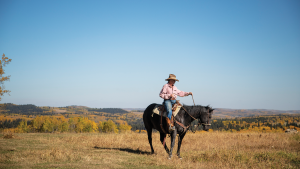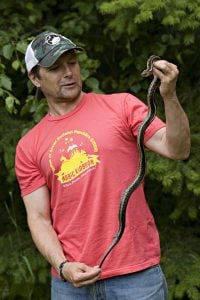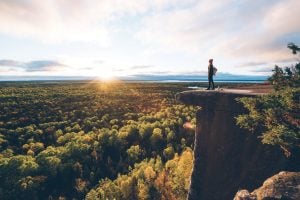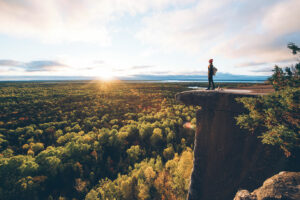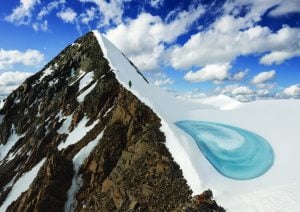I’m sliding across the bottom of an ocean. More precisely, an ocean hundreds of millions of years old thrust some 2,700 metres into the sky. No worries, though — the same sun that once bathed these ancient reefs shines on in a clear blue sky, and the rocky seafloor is nicely cushioned by a generous amount of Canada’s lightest snow — the kind skiers go gaga for. Not only that but I have, in a single leisurely run today on this treeless expanse, skied from Alberta into British Columbia and back again along the Continental Divide, stitching together a drainage that tilts west to the Pacific with one trickling eastward on a long, convoluted journey to the Atlantic. Add in the vista of the extensive lift network I’ve ridden all day and a plethora of fellow skiers enjoying three adjacent mountains like ants at so many picnics, and clearly there is much going on at Sunshine Village ski area outside Banff, Alberta.
Located as it is in the enduring wilderness of venerable Banff National Park, there is also, paradoxically, very little going on. From my vantage atop Lookout Mountain, no other sign of civilization mars the horizon. Only the serrations of the vaunted Rocky Mountains, with icons such as Mount Assiniboine — Canada’s Matterhorn — punctuating the view. Ascending this morning on a 20-minute gondola ride from the shadowy parking lot below imposing Mount Bourgeau to a scatter of buildings that include a vintage, log-walled warden’s cabin and the ultra-modern Sunshine Mountain Lodge, I can’t help but feel gloriously isolated up here — the same feeling that has drawn skiers to this aerie since 1929.
Much of my skiing today has been on the kind of wide-open, impeccably groomed slopes skiers refer to as “cruisers.” But atop Lookout, my ski tips hang in space above Delirium Dive, one of the world’s top off-piste descents, a dizzying run that distills ski history, forces of nature and the trade-offs that come with commercial development in a national park. It just so happens that this stew of historical and contemporary, isolated but accessible, is a microcosm of the very best skiing Alberta has to offer.
Discount the small river-valley ski areas edging most of its Prairie cities, and skiing in Alberta is all about the Front Range of the Rockies: tilted limestone layer cakes skirted in vast swaths of untouched forest, constellated by glaciers and the robin’s-egg-blue lakes gathered at their feet, scenery lauded as some of the world’s most impressive — even by Europeans, who know something of mountain beauty.
Alpine adventure at Marmot Basin
Alberta’s top ski destinations all lie within the UNESCO World Heritage collective that includes Banff and Jasper national parks, linked by the Bow Valley Parkway between Banff and Lake Louise, and the world famous Icefields Parkway joining the latter to the town of Jasper and Marmot Basin, where I’d begun my most recent Front Range ski trip.
Driving north, Marmot spun into view just before Jasper proper, a series of compact ribbons falling toward the broad valley of the Athabasca River. Any notions that it was a small area, however, were laid quickly to rest by terrain unseen from the road. Marmot skis large: a spectrum of broad pistes in the European tradition mix liberally with chunks of legitimate alpine adventure surrounding the Knob and Eagle Ridge chairs. Amazingly, though the last snowfall was many days previous, the treed glades of Eagle East delivered lingering powder, testament to the low mid-week traffic of an area where I never once waited to board a lift.
While the upper mountain deposits you at the hewed-wood warmth of Paradise Lodge, lower runs gather meticulously toward a family-friendly base and a spacious new chalet. Despite increasing numbers of international visitors, Marmot still vibes “Prairie folk,” and parking lots stacked with Alberta plates translated to all eyes in the airy Caribou Lounge glued to a televised women’s curling match between Saskatchewan and Alberta.
With Edmonton four hours distant, many Marmot skiers stay at historic Jasper Park Lodge, originally of the palatial Canadian Pacific Railway hotel chain. Located on the outskirts of a modest town whose three-storey build limit likens it, in some minds, to an early version of Banff, the lodge delivers unparalleled northwoods chic. Outside, steam from a heated pool mixes with mist from the nearby Athabasca, cross-country trails braid the grounds where elk wander uninhibited, and a skating loop circles a small lake. If you had to leave this idyll behind, as I did, the Icefields Parkway offered a perfect exit.
